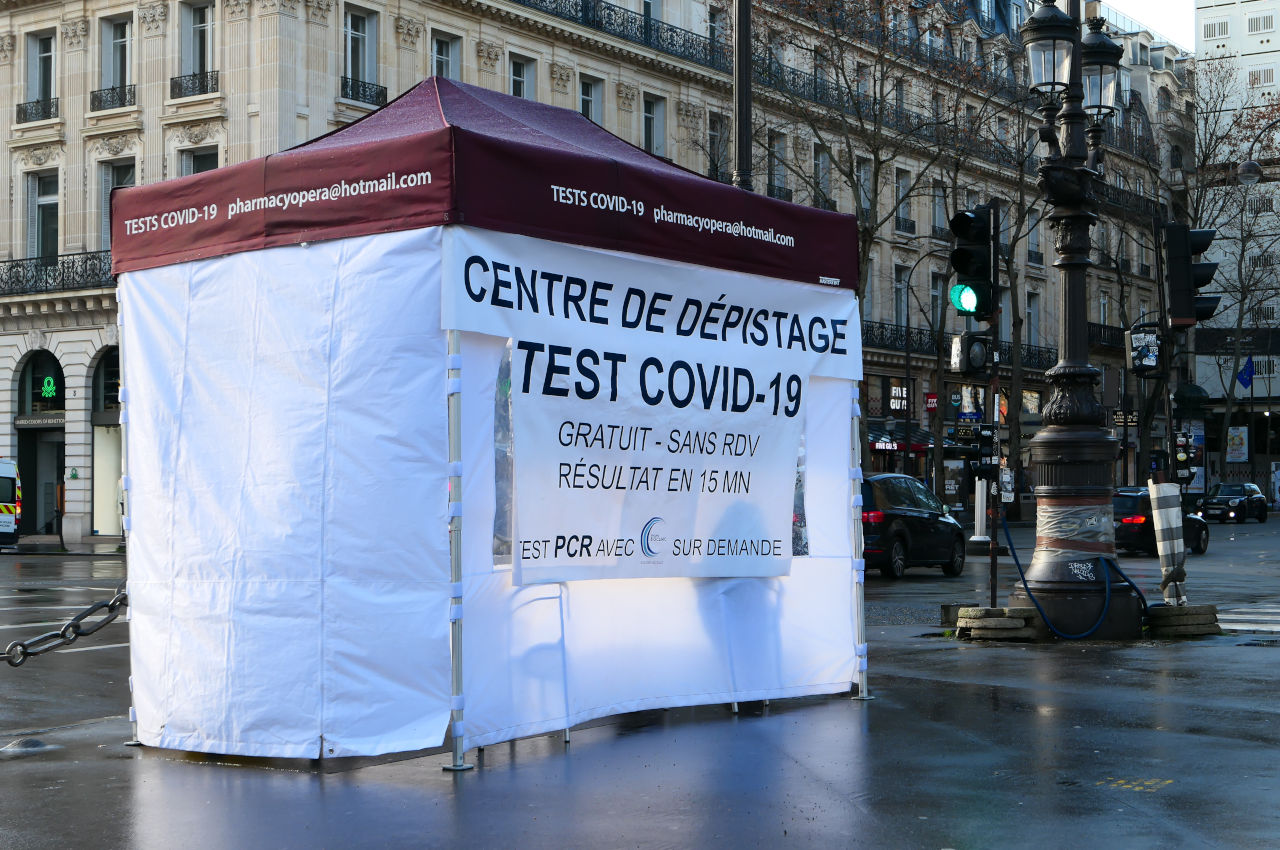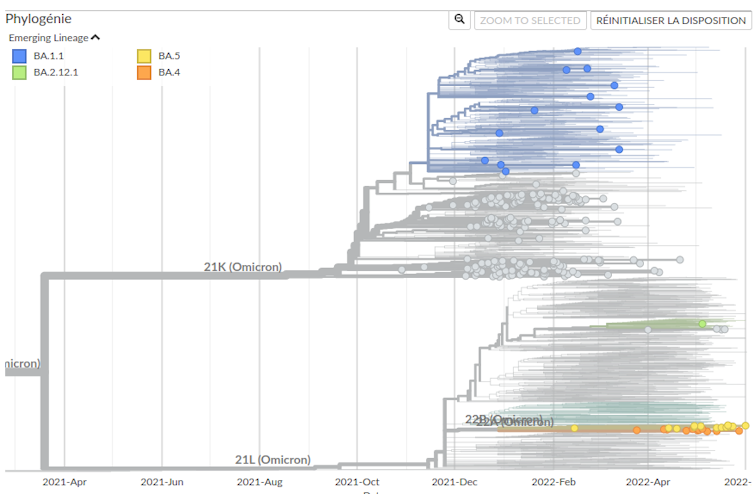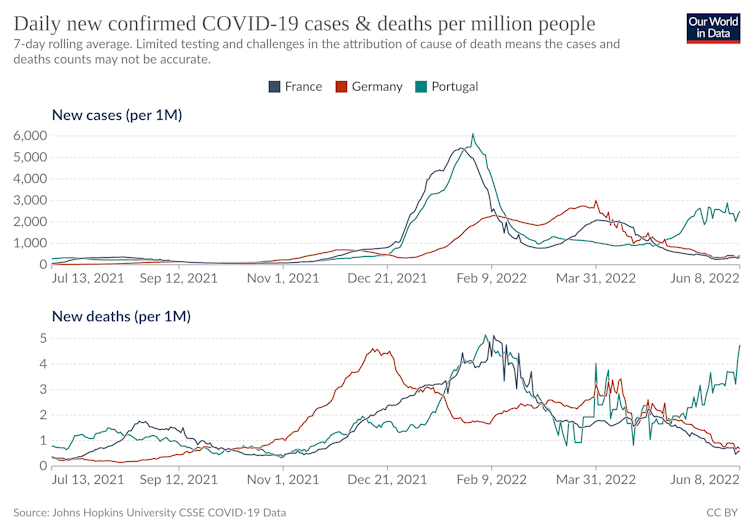Covid epidemic resumes: why Omicron BA.4 and BA.5 variants are spreading to France
Forgotten by the media for several weeks, the Covid epidemic is back in the news, with the BA.4 and BA.5 variants taking hold in France, following their breakthrough in Portugal in particular.
Samuel Alizon, Institute of Research for Development (IRD) and Mircea T. Sofonea, University of Montpellier

Specialists in the epidemiology and evolution of infectious diseases at the "Infectious Diseases and Vectors: Ecology, Genetics, Evolution and Control" unit (University of Montpellier, CNRS, IRD), Mircea Sofonea, senior lecturer, and Samuel Alizon, research director, decipher the situation in France. What can we say about these variants? Will they lead to a new wave this summer?
The Conversation: The Omicron variant, now in the majority worldwide, continues to spread and evolve. But its new avatars are now referred to as BA.1, BA.2, then BA.4 and BA.5... What's the difference?
Samuel Alizon: Yes, it's easy to get lost in all this nomenclature! The Greek letters were introduced by the World Health Organization (WHO) in 2021 with the Alpha variant. This is probably the worst classification ever, as it was drawn up without taking evolutionary biology into account. The Pango and Nextclade classifications are much more appropriate. Moreover, the WHO seems to have stopped updating and is now grouping all BA variants under the generic term Omicron.

Sofonea et al (2022, Emerging Infectious Diseases)
We have modeled the circulation of variant lineages in France in a recent work (see above) and the first Omicron wave caused by the BA.1 lineage emerges as early as the end of 2021. This was quickly supplanted by the BA.2 line, which caused a second hospital wave in April 2022. Now BA.4 and BA.5 are taking over.
Mircea T. Sofonea: These lines were identified in May, but are likely to have emerged in December 2021 in South Africa, potentially from BA.2, the majority line in France since March 2022.
While the BA.2 variant was as different from BA.1 as the Delta variant was from the Alpha variant, the evolutionary divergence between BA.4 and BA.5 is more limited.
However, even if the number of new mutations is limited, some of them are cause for concern. For example, mutation 452R in the Spike protein is known to confer greater affinity with the human ACE2 receptor, used by the virus to enter our cells. The 486V mutation, again in the Spike protein, confers a fairly high degree of immune evasion capacity on the virus.
However, we must be cautious when applying analogical reasoning to isolated mutations. The effect of the latter is neither absolute nor cumulative; it depends on the genotype as a whole, with potential synergistic and antagonistic phenomena, even for distant positions on the genome (known as epistasis).

TC: Are these mutations innovations in these variants, or do BA.4 and BA.5 "pick and choose" from all the possibilities tested by their predecessors - Delta, Gamma, Beta, Alpha?
MTS: Remember that Omicron is not the descendant of previous variants, but a distant cousin, and that viruses don't mutate voluntarily or in a directed way. The mutations detected in the genome of a new lineage appeared by chance.
The 452R mutation was not present in the BA.1 or BA.2 lines, but was indeed found in the Delta variant. It is one of the three mutations sought in the screening tests currently carried out on all positive PCR tests in France.
The 486V mutation is not associated with any of the lineages circulating within our species, but so-called deep mutational scanning experiments, which involve generating proteins with mutations, had identified it as potentially involved in immune evasion.

SA: As far as differences between variants are concerned, two genetic mechanisms are involved: mutations and recombination. When two viruses from different lineages "co-infect" the same host, recombination enables the shuffling of entire portions of the genome.
On the biological level, several hypotheses coexist to explain the emergence of variants: increased circulation in a population, the involvement of an animal reservoir or chronic infections in immunocompromised individuals. The latter are unable to eliminate the virus, which therefore causes longer, more lethal infections. A pre-publication (to be taken with caution, as it has not yet been peer-reviewed) by a New York team describes the intra-patient evolution of a BA.1 virus, with the accumulation of key mutations and, above all, its transmission to at least five other people.
In the case of BA.4 or BA.5, as their differences from BA.2 are fairly limited, they could simply be mutations fixed as the virus circulates.
TC: Why are BA.4 and BA.5 now spreading to France?
SA: It's easy to estimate the growth advantage of one lineage over another in a population. According to our team, BA.5 has a 9% growth advantage over BA.2 in France.
Where this advantage comes from, however, is unclear. Does BA.5 spread more because it's more contagious? Or does it escape immunity more easily? A pre-publication by a Japanese team and a publication by a Chinese team highlight the role of immune escape, notably via the 486V mutation.
Whatever the origin of this advantage, it could contribute to an epidemic rebound in France.
STDs: A second mechanism is also at work in France: anti-SARS-CoV-2 immunity - essentially hybrid, i.e. both post-vaccinal and post-infectious - declines over time since the last immunogenic event (whether infection or vaccination).
While the protection conferred by an Omicron infection or a3rd dose of vaccine remains significant after five months in the case of a severe form, it is much reduced in the case of any infection. The population's susceptibility to the virus (i.e. the counterpart of herd immunity) is therefore reconstituted over time, opening up the possibility of a new epidemic.
In short, BA.4 and BA.5 spread as our immunity ages, and do so more rapidly than BA.2, as they benefit from a double advantage of contagiousness and immune escape. BA.4 and BA.5 therefore induce a wave earlier than BA.2 would have done.
TC: The situation in Portugal may have given cause for concern. But can we learn from trends in other countries?
MTS: I'm cautious about cross-country comparisons: they're increasingly tricky, because current circulation depends not only on the health measures in place, but also on the epidemiological and immunological history, which is increasingly differentiated from country to country.
In France, it's still difficult to make a quantitative comparison between the slackening of measures contributing to the recovery, and the summer context limiting it, with longer, warmer days favoring social interaction in the open air.
SA: Portugal is one of the European countries where the BA.4/BA.5 wave is most advanced, and is accompanied by an increase in hospital admissions. It's hard to say why it started so early, but as with all epidemic start-ups, the role of random "super-propagation" events is probably a major factor.
Worldwide, in South Africa, the BA.4/BA.5 wave seems to be on the wane. In the USA, on the other hand, BA.2 was initially replaced by the BA.2.12 lineage, but this appears to be in the process of being replaced by BA.5.

TC: Is it possible to anticipate the consequences of these replacements between variants on future epidemic peaks?
SA: In 2021, in France, a new variant replaced the old ones, because it was more contagious. Since December 2021, immune evasion has been leading the way.
This makes scenario modeling a tricky business. Our team's models, as well as those of theInstitut Pasteur and the Institut Pierre Louis d'Epidémiologie et de Santé Publique, already take into account vaccination coverage in the population and the percentage of people who have had a natural infection.
On the other hand, including the time elapsed since the last vaccination or natural infection is a challenge, because after two years of pandemic, two vaccination campaigns and a huge BA.1 wave, everyone now has a different immunity!
MTS: We have developed tools to take into account this heterogeneity of immunity in populations. Given our constraints, we are currently focusing on the long term, but in theory it should be possible to use this framework to explore prospective scenarios in the short term.
For the moment, it's hard to say exactly what the scale of the new epidemic wave will be. This wave, in the genetic or virological sense, is already well advanced, and BA.5 is likely to be in the majority by June 20. While summer can be counted on to reduce incidence compared with winter, it will not, on its own, prevent a wave of contamination. For the record, one of France's circulation peaks remains August 2020, and the 4e wave (of Delta) peaked in July 2021.![]()
Samuel Alizon, Director of Research at CNRS, Institute of Research for Development (IRD) and Mircea T. Sofonea, Senior Lecturer in Epidemiology and Evolution of Infectious Diseases, MIVEGEC Laboratory, University of Montpellier
This article is republished from The Conversation under a Creative Commons license. Read theoriginal article.